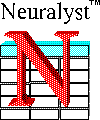
Network
Technology
 |
Neural Network Technology |
Using NeuralystTM for Excel for Investment Analysis |
Figure 1. (30 KB) Neuralyst and Excel combine to make a powerful investment analysis package.
Neuralyst is a general purpose neural network analysis tool for "noisy" or "fuzzy" pattern matching or feature recognition. Neuralyst provides a friendly user interface and a powerful, flexible neural network that is self-programming. You act as a coach for Neuralyst by providing it with data and letting it know the outcomes it should learn. Neuralyst will then train itself on the data and outcomes you have set.
The type of data you present and the way you train the neural network defines a "model" for the application. Once Neuralyst has been trained for a particular application, it can be presented with new data derived from the same or similar sources and it will be able to recognize features consistent with its past learning and advise you on a predicted outcome.
One of the most popular applications for Neuralyst is in the area of investment analysis and price forecasting. Virtually any kind of analysis and forecast can be performed in Neuralyst: fundamental analysis, technical analysis or mixed fundamental/technical analysis. (The Neuralyst manual and disk includes examples of both fundamental and technical analyses). The quality of the forecast depends entirely on the data presented to Neuralyst and the model defined for the neural network.
Neuralyst can work with any kind of numeric data, including price data, technical indicators, macro-economic indicators, interest rates, proprietary signals, etc. If the data is not in numeric form, then a simple conversion may be performed to change categorical or symbolic data into numeric form.
Data may be entered directly through the Excel user interface; data may be read into Excel in a number of file formats: ASCII, Lotus, Excel, DIF, or dBase; or data may be imported from another task on multi-tasking systems through mechanisms such as DDE, Clipboards, etc.
Figure 2. (33 KB) Start with normal price data then add technical indicators or relevant fundamental data.
Neuralyst will work on almost any time scale. Tick-by-tick, hourly data, daily data, weekly data, monthly data, and so on. The primary consideration is that the time scale you use should be reasonable, that is of the same order, for the kind of forecast you are developing. Making monthly forecasts from tick-by-tick data will generally be unsuccessful.
The number of time samples used for training also depends on the type of forecast and underlying data and the market that is represented. Slow moving markets or longer term forecasts may require long data histories. Dynamic markets or short term forecasts may be made with comparatively less data.
There are any number of methods that may be successful. Basically, you should select an equity, future, option, fund, or other security that you wish to analyze. For that instrument, you should identify the fundamental or technical factors that you believe are most relevant and include these in your data. Then identify the kind of forecast that is most relevant to you given your investment strategy and trading style. There are a number of forecasts that are possible, but generally price direction or price level are most interesting. Train and test the neural network using this model. If test results are not satisfactory, then revise the model. Otherwise, you can include the forecast as a component of your decision process.
For example, a basic technical analysis model could start with daily price data. Additional inputs to the neural net could include indicators such as a 7-day momentum, an 11-day versus 35-day moving average oscillator, and both %K and %D stochastic oscillators. The neural network would be trained on between 80-200 days of price and indicator data. The training target for the output would be a prediction of the next day's price direction, up or down, filtered by a minimum price movement requirement. Once the neural network has been trained to this model, it could be tested on new or reserved price data. With successful test results, the neural network can now be included in your analysis repertoire.
Customers have used Neuralyst for stock index price direction prediction using basic technical analysis inputs and daily data; exchange rate futures high, low, open, and close price level prediction using tick-by-tick data; coffee futures price prediction using a mix of futures prices, spot prices, exchange rates, and crop forecasts; mutual fund rate-of-return prediction using net asset values, bond prices, stock index prices, and gold prices on a weekly basis; and others. The possibilities are as numerous as there are securities or other financial instruments.
In addition to its powerful neural network analysis capabilities, Neuralyst includes a Trader's Macro Library, which helps you build more sophisticated technical analysis applications supporting some of the most popular operations and technical indicators used by investors and traders.
The Trader's Macro Library has detrending operations such as logarithms and first differences and technical indicators such as moving average, exponential average, moving average oscillator, momentum, relative strength indicator, stochastic oscillator, MACD, on balance volume, volatility, and others.
Figure 3. (32 KB) Neuralyst with Trader's Macro Library dialog box active.
The use of Neuralyst for investment, trading, speculation, gambling, or other similar or related purposes is at the user's risk. Results generated by Neuralyst are dependent on past information and there is no guarantee that future results can be forecast or predicted by Neuralyst. Investing or trading in stocks, futures, and other securities or any form of speculation or gambling is inherently risky and may result in loss.